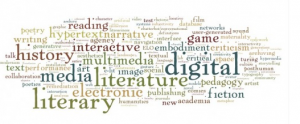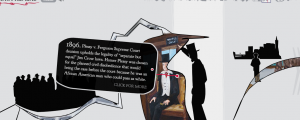In her book Electronic Literature: New Horizons for the Literary, Katherine Hayles defines “electronic literature” as “work with an important literary aspect that takes advantage of the capabilities and contexts provided by the stand-alone or networked computer” (3). In the classic sense, literature refers to the written medium exclusively. Thus, “e-lit” has many distinct characteristics that validate its existence as a separate medium. It is afforded certain functions that augment the reading experience in a unique way; when comparing it to popular media such as film, video games, or print, e-lit bridges the gap between text and multimedia most effectively. In other words, the balance between writing and audiovisual content is the most even. In addition, e-lit is able to utilize a wider variety of tools that enable authors to create a very specific experience for their audience (more so than static illustrations alone). These artistic media elements can be merely supplementary or integral components of the work, both of which can be seen in Eric Lemay’s “Losing the Lottery” and Mark Marino’s “Living Will.”
Lemay’s “Losing the Lottery” features a very interesting media element to supplement its writing. The work first brings you to a lottery mini-game: the screen shows rapidly moving random lottery balls with numbers, six of which the reader must choose to continue. The reader is then shown a two-column layout that displays a lottery simulator algorithm on the right side and a collection of 49 pages on the right side. Each of the 49 pages has a short paragraph, quote, or absurd statistic that has something related to the unlikelihood of winning the lottery, interspersed with personal anecdotes and thoughts from the author. The lottery simulator uses the six numbers chosen by the reader and cycles through randomly generated lottery sequences, with headers that show the number of times you have won, the degree to which your numbers match, and the time and money spent/earned playing the lottery.

“Losing the Lottery,” Eric Lemay
This media element is supplemental to the text, but definitely enhances the simple message being portrayed. The combination of short excerpts and the miniscule winnings shown by the simulator shows the reader on a deeper level just how futile it is to play the lottery. The simulator serves as a personalized firsthand experience, and quietly runs alongside the text as you read. It allows the reader to glance over to the right and view his or her “progress,” while simultaneously taking in information about how difficult it is to win the lottery. Although the message in this piece is pretty simple, it is a very clear demonstration of how such a media element can simultaneously reinforce the ideas of a text effectively. This interactive simulator is a much more interesting method of visualizing an idea than merely showing data aggregates in a graph or table. While the simulation might not be essential, the work would be far less interesting without it.
Media elements can also play an integral role in the consumption of an e-lit work; Mark Marino’s “Living Will” is a great example. This piece functions as a highly interactive click-and-scroll story that allows the reader to choose what happens on a whim. As the reader scrolls through and reads the will, different parts of the text become clickable. Depending on what the reader selects, the document will alter itself instantly. The left hand side of the page has a box that explains who the reader is and what he or she is reading, and the right side of the screen features a simulator (just like Lemay’s piece) that runs simultaneously as the reader goes through the document, tallying up the inheritance (bequests, fees, taxes, etc.). In addition, the simulator features multiple points-of-view that let the reader see how much money the different characters of the work have earned as a result of the reader’s browsing through the document. This media element is very immersive and provides a rich storytelling experience. In a way, this feels like a role-playing video game (RPG), in that the decisions that the reader makes alters the course of the story. However, each of the various permutations of the path follows a parent storyline, implying that all arcs will eventually lead to the same conclusion.

“Living Will,” Mark Marino
This type of e-lit piece shows the powerful applications the medium can have when it comes to fictional storytelling. It is hard to compare this to film or video because it is mostly comprised of words as opposed to moving images; however, it is a dynamic experience that could be more aptly described as a video game of sorts (maybe not the most entertaining or colorful, but certainly interactive).
One of the few flaws that e-lit pieces are unable to rectify currently is the issue of accessibility. While they can serve as very interesting and immersive methods of consuming literature, one must have a computational device (a smartphone, computer, tablet) to experience it, which restricts access to many different people. Also, depending on which device is used, the full experience can vary. Personally, I would not enjoy navigating through “Living Will” on a small smartphone screen as opposed to a regular laptop screen. These are all considerations the author must put into account when producing a work. Furthermore, while this is not necessarily a limitation to the medium, it is difficult to reproduce such a work and present it in other media, as the author has purposefully designed the work with a specific representation in mind. Having a knowledge of coding flash/java/html scripts would be quite useful in attempting to do so.
While “Losing the Lottery” and “Living Will” are quite in depth, they do not showcase the entire range that the e-lit medium possesses. Some other e-lit works such as Robert Kendall’s “Candles for a Street Corner” or Campbell and Jhave’s “Zone” feature much more audiovisual content than text. In this way, they are more similar to other visual-heavy media such as graphic novels or film. There is an emphasis on what is seen in order to communicate certain emotions and feelings more effectively than text alone. However, one cannot exist without the other in e-lit pieces; without the writing to justify the media element, it is enormously difficult (and often unsatisfying) to navigate these elements without direction or apparent purpose. This is one of the reasons why the e-lit medium has such great potential as an effective means of telling a story or communicating information – the tools it has in its arsenal to relay a multidimensional experience far outnumber those which books can employ, which help the reader understand works on a significantly more personal and profound level.
Works Cited
Campbell, Andy, and Jhave. “Dreaming Methods : Zone.” Dreaming Methods : Zone. Dreaming Methods, 2013. Web. Nov.-Dec. 2013. <http://labs.dreamingmethods.com/zone/>.
Hayles, Katherine. Electronic Literature: New Horizons for the Literary. Notre Dame, IN: University of Notre Dame, 2008. Print.
Kendall, Robert, and Michele D’Auria Studio. “Candles for a Street Corner.” Candles for a Street Corner. Michele D’Auria Studio, July 2004. Web. Nov. 2013. <http://www.bornmagazine.org/projects/candles/>.
Lemay, Eric. “DIAGRAM :: Eric LeMay.” DIAGRAM :: Eric LeMay. N.p., n.d. Web. 04 Dec. 2013. <http://thediagram.com/11_5/lemay.html>.
Marino, Mark. “Living Will.” Living Will. Markcmarino.com, 2010. Web. Nov. 2013. <http://markcmarino.com/tales/livingwill.html>.








